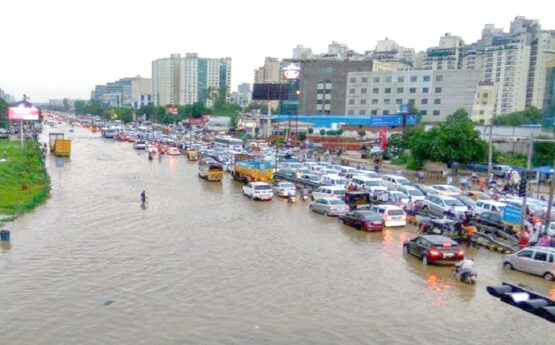Background
As cities expand and populations rise, the interaction between urban development and natural systems becomes more intricate, leading to a higher risk of floods. This blog explores the relationship between urbanization and flood vulnerability in India, shedding light on the underlying causes, consequences, and potential solutions.
How urban growth alters natural landscapes
Urban areas can grow from increases in human populations or from migration into urban areas and this often results in deforestation, habitat loss, and the extraction of freshwater from the environment, which can decrease biodiversity and alter species ranges and interactions. With high urbanization, natural permeable surfaces are getting replaced by impermeable ones like cement and asphalt making a city more Concrete in nature. This change in landscape disrupts the natural water cycle, leading to reduced infiltration and increased surface runoff during heavy rains.
The pace and nature of expansion in urban areas are mostly unplanned and unregulated. As a result, the changed composition and layout of the landscape are influencing crucial ecological processes that contribute to human well-being. Pressure on conventional drainage systems causes them to overflow and exacerbates flooding in urban areas.

Stormwater Management in Urban Areas
Effective stormwater management involves the endeavor to diminish and direct the runoff of rainwater originating from urban regions, including streets, lawns, and residences. This practice also serves to counteract the negative consequences of urban stormwater flooding caused by human activities such as infrastructure development. Exploring eco-friendly strategies like green infrastructure, comprising methods such as rain gardens and permeable pavements plays a significant role in diminishing surface runoff and offers sustainable solutions to counteract flooding in urban areas.
Moreover, these gardens introduce greenery and wildlife habitats, while permeable pavements offer an innovative and environmentally friendly alternative to traditional pavements. Incorporating green infrastructure promotes sustainable land-use practices by optimizing available space to serve both functional and ecological purposes.
Importance of Community Resilience and Awareness
The active participation of local communities and the dissemination of knowledge play pivotal roles in minimizing the susceptibility to flooding. By understanding the impact of their actions on local water systems, communities can adopt behavior and take initiatives that reduce flood risk. Examples include community clean-up drives, rainwater harvesting projects, and neighborhood-level drainage maintenance etc.
Educating residents about flood risks, safe practices, and emergency protocols is important. Workshops, seminars, and training sessions help individuals understand the dynamics of floods, recognize warning signs, and learn how to respond appropriately. Avoiding indiscriminate dumping of waste, maintaining drainage systems, and refraining from building on natural drainage systems and catchment areas are examples of informed decisions that not only contribute to risk reduction but also foster a sense of collective responsibility and ownership.

Move to resilience thinking in Planning
From the standpoint of planning professionals, achieving resilience necessitates augmenting current methodologies and strategies to render cities and crucial infrastructure more resilient against the external impacts of flooding. This paradigm emphasizes adapting and preparing for the dynamic nature of floods, fostering the capacity to withstand and recover from their impacts.
Government initiatives like the Sponge Cities mission can go a long way in helping civic authorities to plan cities keeping flood risks in mind. Sponge city initiatives,” are a holistic approach to urban planning and development aimed at mitigating the impact of urban flooding. These initiatives focus on enhancing a city’s ability to absorb, manage, and reuse rainwater, reducing the risk of floods and their associated damages. Sponge cities bring about a range of advantages, such as lowering the threat of floods, enhancing water quality, enriching green areas, and boosting the general resilience of urban areas. Nonetheless, the successful implementation of sponge city projects necessitates meticulous preparation, effective cooperation among involved parties, adequate financial resources, and tailoring the approach to align with the distinct circumstances and requirements of each city.
Author-Madhavi Nikose
